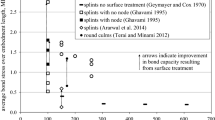Abstract
Autoclaved aerated concrete (AAC) is a light-weight cementitious product of sand, water, cement, lime and aluminium powder mix, used globally for brickwork. The AAC blocks in vogue have smooth surfaces, due to which they have less bond strength than that of traditional clay bricks. This work asserts that the shear bond strength of AAC masonry can be enhanced by using grooved AAC blocks. The compressive strength of the grooved AAC block as well as the shear bond and compressive strengths of the masonry have been investigated experimentally and compared with conventional AAC blocks and masonry. The study clearly demonstrated the superiority of grooved AAC blocks to conventional AAC blocks. Simple analytical models have been developed to estimate the masonry compressive and shear bond strengths. Analytical models are capable of obtaining lower, upper and most likely estimates of strengths. Significance tests have been carried out to support the findings.



Similar content being viewed by others
References
Venkatarama Reddy BV, Uday Vyas CV (2008) Influence of shear bond strength on compressive strength and stress–strain characteristics of masonry. Mater Struct 41(10):1697–1712
Venkatarama Reddy BV, Lal R, Nanjunda Rao KS (2007) Enhancing bond strength and characteristics of soil–cement block masonry. J Mater Civ Eng 19(2):164–172
Sarangapani G, Venkatarama Reddy BV, Jagadish KS (2005) Brick-mortar bond and masonry compressive strength. J Mater Civ Eng 17(2):229–237
Dixit US, Borsaikia AC, Raj A (2018) Autoclaved aerated concrete (AAC) block unit comprising in built anchorage/frog on surface for enhancement of bonding and lateral/shear strength in masonry wall system. In: India Patent Office Journal no. 36/2018, Application number: 201831028883
Singh SB, Munjal P (2017) Bond strength and compressive stress-strain characteristics of brick masonry. J Build Eng 9:10–16
Sinha BP (1967) Model studies related to load bearing brickwork. PhD thesis, University of Edinburgh, UK
Groot Caspar JWS (1993) Effects of water on mortar brick bond. PhD thesis, University of Delft, Delft, The Netherlands
Rao KVM, Venkatarama Reddy BV, Jagadish KS (1996) Flexural bond strength of masonry using various blocks and mortars. Mater Struct 29(2):119–124
Małyszko L, Kowalska E, Bilko P (2017) Splitting tensile behavior of autoclaved aerated concrete: comparison of different specimens’ results. Constr Build Mater 157:1190–1198
Ferretti D, Michelini E, Rosati G (2015) Cracking in autoclaved aerated concrete: experimental investigation and XFEM modelling. Cem Concr Res 67:156–167
Ferretti D, Michelini E, Rosati G (2015) Mechanical characterization of autoclaved aerated concrete masonry subjected to in-plane loading: experimental investigation and FE modeling. Constr Build Mater 98:353–365
Jasiński R, Drobiec Ł (2016) Comparison research of bed joints construction and bed joints reinforcement on shear parameters of AAC masonry walls. J Civ Eng Archit 10:1329–1343
Mallikarjuna S (2017) Experimental determination of parameters for a micro-modeling based failure criterion for AAC block masonry shear wall. MTech thesis, Indian Institute of Technology, Guwahati, India
Bhosale A, Zade NP, Davis R, Sarkar P (2019) Experimental investigation of autoclaved aerated concrete masonry. J Mater Civ Eng (ASCE) 31(7):04019109
Rosti A, Penna A, Rota M, Magenes G (2016) In-plane cyclic response of low-density AAC URM walls. Mater Struct 49(11):4785–4798
Abed F, Aidan A, Ibrahim T, Hegazi N, Al-Dabagh S (2017) Preparation of a new AAC-concrete sandwich block and its compressive behavior at quasi-static loading. Eng Trans 65(2):371–389
Raj A, Borsaikia AC, Dixit US (2019) Bond strength of autoclaved aerated concrete (AAC) masonry using various joint materials. J Build Eng. https://doi.org/10.1016/j.jobe.2019.101039
Raj A, Borsaikia AC, Dixit US (2018) Manufacturing of autoclaved aerated concrete: present status and future trends. In: Proceedings of 6th international and 27th all india manufacturing technology, design and research conference (AIMTDR-2018), Anna University, Chennai, India
IS: 1077 (1992) Common burnt clay building bricks-specifications. Bureau of Indian Standards, New Delhi
IS: 2250 (1995) Indian standard code of practice for preparation and use of masonry mortars. Bureau of Indian Standards, New Delhi
Alecci V, Fagone M, Rotunno T, De Stefano M (2013) Shear strength of brick masonry walls assembled with different types of mortar. Constr Build Mater 40:1038–1045
IS: 1905 (1987) Indian standard code of practice for structural use of unreinforced masonry. Bureau of Indian Standards, New Delhi
ASTM: E447-97 (2017) Test methods for compressive strength of laboratory constructed masonry prisms. ASTM International, Pennsylvania
ASTM: C1314-16 (2016) Standard test method for compressive strength of masonry prisms. ASTM International, West Conshohocken
Dixit PM, Dixit US (2008) Modeling of metal forming and machining processes: by finite element and soft computing methods. Springer, London
Acknowledgements
This work is the part of Department of Science and Technology (DST), India, sponsored project entitled “Design and development of proper bonding mechanism for individual AAC block units in wall system of a structure” through grant number DST/TSG/AMT/2015/375. Authors wish to acknowledge DST and industry partner M/s. K D Infra, Guwahati for their support.
Author information
Authors and Affiliations
Corresponding author
Ethics declarations
Conflict of interest
The authors declare that they have no conflict of interest.
Additional information
Publisher's Note
Springer Nature remains neutral with regard to jurisdictional claims in published maps and institutional affiliations.
Electronic supplementary material
Below is the link to the electronic supplementary material.
Appendix: Data of compressive load carrying capacity of the blocks
Appendix: Data of compressive load carrying capacity of the blocks
Compressive test result data for AAC block and masonry are presented in Tables 5 and 6. The values in square bracket represent percentage coefficient of variation. A large statistical variation is observed.
Rights and permissions
About this article
Cite this article
Raj, A., Borsaikia, A.C. & Dixit, U.S. Compressive and shear bond strengths of grooved AAC blocks and masonry. Mater Struct 52, 116 (2019). https://doi.org/10.1617/s11527-019-1428-8
Received:
Accepted:
Published:
DOI: https://doi.org/10.1617/s11527-019-1428-8




